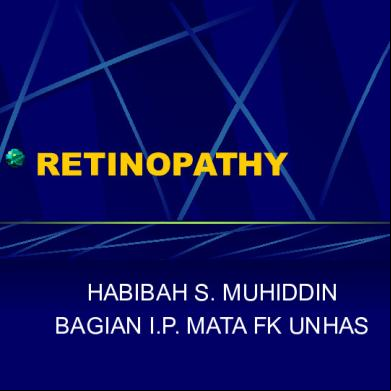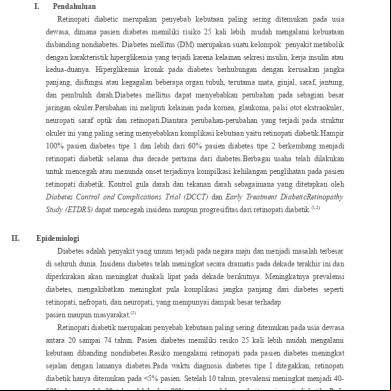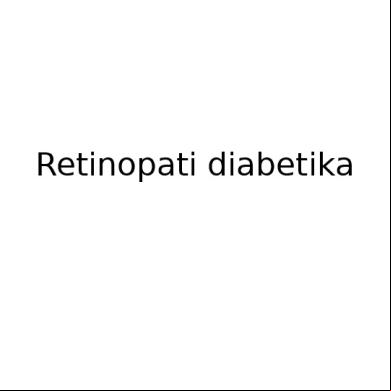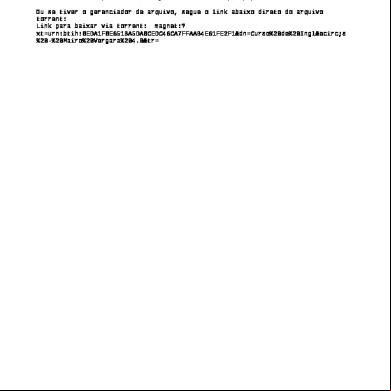Retinopati 1t4j12
This document was ed by and they confirmed that they have the permission to share it. If you are author or own the copyright of this book, please report to us by using this report form. Report 2z6p3t
Overview 5o1f4z
& View Retinopati as PDF for free.
More details 6z3438
- Words: 583
- Pages: 52
RETINOPATHY
HABIBAH S. MUHIDDIN BAGIAN I.P. MATA FK UNHAS
Fundus normal
Papil normal
DIABETIC RETINOPATHY Frequent cause of blindness in USA, aged 20 to 64 years Indonesia blindness due to D.R. increase
PATHOGENESIS The exact cause is still unclear It is believed :
Hiperglycemia over an extended period results in a number biochemical and physiologic changes --endothelial damage. Retinal vascular changes : loss of pericyte basement membrane thickening---compromises capillary lumen--- decompensation of endothelial barrier function
Hematologic and biochemical abnormalities Increased platelet adhesiveness Increaser erythrocyte aggregation Abnormal serum lipids Defective fibrinolysis Abnormal levels of growth hormone : ex vascular endothelial growth factor (VEGF) Abnormalities in serum and whole blood viscosity
ADVANCED DIABETIC RETINOPATHY
Risk factor for : Cardiovascular disease Heart attack Stroke Diabetic nephropathy Amputatia Death
CLASSIFICATION Non proliferative diabetic retinopathy (NPDR) = back ground diabetic retinopathy :
Mild Moderate Severe Very severe
Proliferative Diabetic Retinopathy :
Early High risk Advanced
Macular edema
NPDR : Retinal microvasculer changes limited to the retina
Micro aneurysme Dot & blot hemorrhage Retinal edema Hard exudates Dilatation & bleading of the vein Intraretinal micro vascular abnormalites (IRMA) Nerve fiber layer infarct (cotton wool spot) Areas of capillary non perfussion
RH :
RD tahap awal
RD : mikroaneurisma + hard exudate
Gamb. fluoresin
RD 1: cotton wool + Flame shaped
RD 2
RD 2 (fluoresin)
Affect visual function through Capillary disease ischemic Vascular permeability edema
Diabetic macular edema
The most common : Cause of VA Cause focal Cause diffuse
Proliferative diabetic retinopathy (PDR) Extra retinal fibrovascular proliferation extends beyond the ILM
RD proliferatif
NPDR Ischemic retina Release of vaso poliferative factors Neovascularization of the retina optic neuro head, ant.signal
RD proliferatif
COMPLICATION Reduced of visual acuity Vitreous hemorrhage Traction retinal detachment Neurovascular glaucoma
RD prolif.+ ablasio
TREATMENT Regulation of blood glucose level Laser photocoagulation Vitrectomy
RD prolif + tx laser
HYPERTENSIVE RETINOPATHY Effect of systemic arterial hypertension
to chronic retinal vascularization Hypertensive retinopathy Hypertensive choroidopathy Hypertensive optineuropathy
HYPERTENSIVE RETINOPATHY (HR) Hypertensive vascular changes & arterio sclerata vascular disease express in HR. Classification of HR, the modified scheir. Grade 0 : No change (a/v 2 : 3) Grade 1 : barely table arterial narrowing a:v=1:2
CLASSIFICATION OF HR Grade 2 : obvious arterial narrowing with focal irregularities. Copper wire arteries Silver wire arteries Banking sign Salus sign
RH : crossing/Gunn sign
RH : Gunn phenomen
RH: gunn, copper wire, Salus
RH dg Gunn phenomen
Classification. cont Grade 3 : grade 2 + retinal hemorrhages and/or exudate Grade 4 : grade 3 + disc swelling
Associated condition Branch retinal artery occlusion (BRAO) Branch retinal vein occlusion (BRVO) Central retinal vein occlusion (CRVO) Retinal arterial macroaneurysms Preretinal and vitreous hemorrhage Epiretinal membrane
HYPERTENSIVE CHOROIDOPATHY
Typically occur in young patients : with acute hypertension ex : Preeclampsia, eclampsia Pheochromacytoma Acute renal failure
RH pd HT renal
RH ok HT renal + edem papil
Funduscopic findings
Choriocapillaries nonperfusion Hemorrhages Retinal edema Infark nerve fiber layer RPE detachment Retinal detachement
RH ok HT renal + edem papil
Hypertensive Optic Neuropathy
Flame-shaped hemorrhages around the disc Blurring of the disc margin Congestion of the retinal vein Secondary macular exudates
Retinopati angiospastik : cotton wool + flame shaped + dot hemorrhage
Other types of retinopathy Leukemia retinopathy Thrombocytopenia retinopathy Anemia retinopathy
Trombositopenia
Hemofilia
Leukemia akut
HABIBAH S. MUHIDDIN BAGIAN I.P. MATA FK UNHAS
Fundus normal
Papil normal
DIABETIC RETINOPATHY Frequent cause of blindness in USA, aged 20 to 64 years Indonesia blindness due to D.R. increase
PATHOGENESIS The exact cause is still unclear It is believed :
Hiperglycemia over an extended period results in a number biochemical and physiologic changes --endothelial damage. Retinal vascular changes : loss of pericyte basement membrane thickening---compromises capillary lumen--- decompensation of endothelial barrier function
Hematologic and biochemical abnormalities Increased platelet adhesiveness Increaser erythrocyte aggregation Abnormal serum lipids Defective fibrinolysis Abnormal levels of growth hormone : ex vascular endothelial growth factor (VEGF) Abnormalities in serum and whole blood viscosity
ADVANCED DIABETIC RETINOPATHY
Risk factor for : Cardiovascular disease Heart attack Stroke Diabetic nephropathy Amputatia Death
CLASSIFICATION Non proliferative diabetic retinopathy (NPDR) = back ground diabetic retinopathy :
Mild Moderate Severe Very severe
Proliferative Diabetic Retinopathy :
Early High risk Advanced
Macular edema
NPDR : Retinal microvasculer changes limited to the retina
Micro aneurysme Dot & blot hemorrhage Retinal edema Hard exudates Dilatation & bleading of the vein Intraretinal micro vascular abnormalites (IRMA) Nerve fiber layer infarct (cotton wool spot) Areas of capillary non perfussion
RH :
RD tahap awal
RD : mikroaneurisma + hard exudate
Gamb. fluoresin
RD 1: cotton wool + Flame shaped
RD 2
RD 2 (fluoresin)
Affect visual function through Capillary disease ischemic Vascular permeability edema
Diabetic macular edema
The most common : Cause of VA Cause focal Cause diffuse
Proliferative diabetic retinopathy (PDR) Extra retinal fibrovascular proliferation extends beyond the ILM
RD proliferatif
NPDR Ischemic retina Release of vaso poliferative factors Neovascularization of the retina optic neuro head, ant.signal
RD proliferatif
COMPLICATION Reduced of visual acuity Vitreous hemorrhage Traction retinal detachment Neurovascular glaucoma
RD prolif.+ ablasio
TREATMENT Regulation of blood glucose level Laser photocoagulation Vitrectomy
RD prolif + tx laser
HYPERTENSIVE RETINOPATHY Effect of systemic arterial hypertension
to chronic retinal vascularization Hypertensive retinopathy Hypertensive choroidopathy Hypertensive optineuropathy
HYPERTENSIVE RETINOPATHY (HR) Hypertensive vascular changes & arterio sclerata vascular disease express in HR. Classification of HR, the modified scheir. Grade 0 : No change (a/v 2 : 3) Grade 1 : barely table arterial narrowing a:v=1:2
CLASSIFICATION OF HR Grade 2 : obvious arterial narrowing with focal irregularities. Copper wire arteries Silver wire arteries Banking sign Salus sign
RH : crossing/Gunn sign
RH : Gunn phenomen
RH: gunn, copper wire, Salus
RH dg Gunn phenomen
Classification. cont Grade 3 : grade 2 + retinal hemorrhages and/or exudate Grade 4 : grade 3 + disc swelling
Associated condition Branch retinal artery occlusion (BRAO) Branch retinal vein occlusion (BRVO) Central retinal vein occlusion (CRVO) Retinal arterial macroaneurysms Preretinal and vitreous hemorrhage Epiretinal membrane
HYPERTENSIVE CHOROIDOPATHY
Typically occur in young patients : with acute hypertension ex : Preeclampsia, eclampsia Pheochromacytoma Acute renal failure
RH pd HT renal
RH ok HT renal + edem papil
Funduscopic findings
Choriocapillaries nonperfusion Hemorrhages Retinal edema Infark nerve fiber layer RPE detachment Retinal detachement
RH ok HT renal + edem papil
Hypertensive Optic Neuropathy
Flame-shaped hemorrhages around the disc Blurring of the disc margin Congestion of the retinal vein Secondary macular exudates
Retinopati angiospastik : cotton wool + flame shaped + dot hemorrhage
Other types of retinopathy Leukemia retinopathy Thrombocytopenia retinopathy Anemia retinopathy
Trombositopenia
Hemofilia
Leukemia akut










